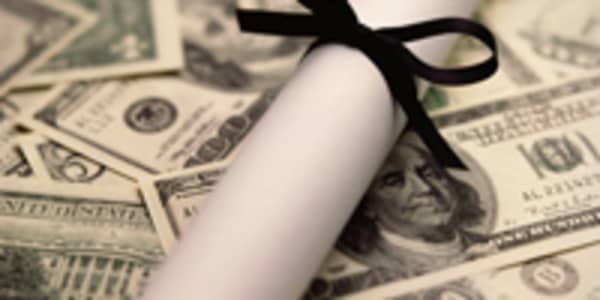Sitting in the kitchen of his San Francisco apartment, Kyle McCarthy could not hold back the tears.
“I know I have to pay ‘em. I-- I-- I know and I will,” McCarthy said, sobbing. “I just-- I-- I never said I wouldn’t, you know?”
But he has no idea how.
McCarthy, 28, has a master’s degree—and, he estimates, $72,000 in student debt. His job at a local Border’s bookstore barely pays him enough to meet his rent, let alone the demands of the collection agents that he says call him at all hours of the day.
“I’ve tried to work out anything for them, you know? Like I can pay this amount of money. I can pay $50 a month. And it was, ‘No.’ It was, ‘You need to pay the full amount now or we’re just gonna' take it out of your paycheck."
Now, McCarthy is bracing for possible eviction, and lives in fear the collectors will pursue his mother in Maryland.
“I can’t get out, you know?” he says.
McCarthy’s plight is neither as extreme or rare as one might think.
Just ask around.
Chances are your friends and co-workers have student loans. Maybe you do, too. You all have plenty of company.
The explosion of student debt is explored in the CNBC Original documentary, “Price of Admission: America’s Student Debt Crisis.” (Check for program times.).
In 2009, the most recent data available, 67 percent of graduates had debt, averaging $24,000 per student, up 6 percent from the previous year, according to the non-profit Project on Student Debt. The numbers are even higher at private institutions.
The figures do not include the growing number of loans taken out by parents, and only limited data on for-profit colleges, where student debt is typically much higher, but relatively few institutions report it.
Americans now owe more on their student loans than they do on their credit cards—a first, according to , which has created what it calls the Student Loan Debt Clock.
The organization figures America’s student loan debt is growing at a rate of $2,853.88 per second. At this pace, it will surpass $1 trillion in 2012. And there is no sign of the pace letting up. On the contrary.
“The need to borrow has grown for all types of students at all types of schools,” says Lauren Asher, director of the Project on Student Debt. “And the amount that students are borrowing is driven by the share of cost that students and families are expected to cover after aid.”
But Asher says college costs are rising faster than family incomes and faster than grants and scholarships. A lot faster.
The cost of a college education is increasing two to three times the overall rate of inflation, according to the U.S. Bureau of Labor Statistics. College costs are even rising faster than the cost of medical care.
“Frankly, one of the big drivers is state budgets,” says Asher. With state finances under pressure, public universities are relying more heavily on their students, raising tuition and recruiting more out-of-state students who pay higher rates.
Add to that a growing system of for-profit colleges and universities, many of which cater to lower income learners, and the demand for borrowed funds is being stretched to the limit. And with the worst job market for graduates in a generation, some worry the whole system could go over the edge.
“There's a lot of similarities between what's happening with student loans and the housing crisis,” says Iowa Senator Tom Harkin, chairman of the Senate Committee on Health, Education, Labor and Pensions.
But there is also a key difference: unlike a mortgage, in which a borrower can refinance or—at worst—face foreclosure and bankruptcy, student loans do not go away.
“They got it hung around their necks until they pay off every last dime of it,” says Harkin.
That is because by law, except in very rare circumstances, student loans cannot be wiped out in bankruptcy, and there are very limited options for refinancing or restructuring them.
Instead, borrowers face garnishment of wages, government seizures of their tax refunds and social security payments, and the loss of professional licenses—leaving them even less able to pay their student debts.
Thanks to the recession, the number of graduates finding themselves in that very predicament is rising. Student loan defaults have doubled since 2005, according to the U.S. Department of Education.
Seeing no way out, some are taking drastic measures.
Desperate Borrowers
“We’ve had multiple instances of suicides,” says Alan Collinge, who began fighting to restore consumer protections to student loans after defaulting on his own student loans.
Collinge wrote a book, "The Student Loan Scam" (Beacon Press, 2009), and created a web site, studentloanjustice.org, where borrowers seek advice and share stories.
Collinge says he knows of at least three dozen people who fled the country to escape their student debt—“the most ridiculous thing I can imagine,” Collinge says.
Kyle McCarthy is one of those who contacted Collinge for help.
McCarthy’s problems began about four months after he graduated from the University of San Francisco in 2007. He had dreamed of working with student athletes, and possibly coaching high school soccer. But then he blew out his knee in a soccer game.
“I was bed ridden for a couple months. I mean, I obviously couldn’t go to work,” McCarthy says. He was scheduled to begin repaying his student loans in June, six months after graduation.
“My mom was making calls at that time, letting them know what was going on. I was trying to make calls.” But it was to no avail.
“Each step of the way, it seemed like it was sort of purposely made to be confusing,” he says.
McCarthy says he can’t leave his job at Border’s to find something that pays better, because the job includes health insurance that helps pay for his physical therapy. In addition, he fears the damage to his credit because of the student loan default is making him unemployable anywhere else.
Multiple student borrowers tell similar stories of insurmountable debt and interminable bureaucracy.
For Nick and Emily Hauptmann of Round Lake Heights, Illinois, their student loans are their only debt. But at more than $250,000, it’s all the debt they will ever need.
The couple fell in love while in college, married young and started a family. But they were determined to continue their education—Emily training to become a paralegal; Rick, a Certified Public Accountant, working toward his MBA.
Juggling family and school meant an education in fits and starts, and more than the usual amount of student loans. Still, they reasoned, the education would give them the edge they needed in a competitive job market.
“I asked Nick, ‘Can we afford this,’” says Emily. “And he said, ‘You know, we can't afford not to.’"
The couple got their degrees, and ran headlong into the recession. Unemployed, they were allowed to go into forbearance on their loans, but all the while, interest was accruing, just as it had while they were in school.
Now they say, when they begin repaying the loans, they face payments of $1,760 a month for 25 years—payments totaling $528,000, of which $275,000 is interest.
“It feels like having a mortgage,” says Rick, except he and his wife have little to show for it.
“Feels like we're not going on vacation. We're not fixing the house. We're not—Sophie—I didn't even—I didn't get to put her in CCD this year,” Emily said of her oldest daughter, now six. “It's her communion. You know, she's gonna miss it.”
The federal government has taken some steps to help keep borrowers from defaulting. A program known as income-based repayment allows borrowers to cap their monthly payments based on a percentage of their income. If they make timely payments for 25 years, the remainder of the loan will be forgiven, but the amount forgiven is treated as taxable income. The loan can be forgiven after ten years if the borrower works in a public service career.
The program, however, has serious limitations. It only applies to federal student loans that have not gone into default. Private loans—a growing source of credit for students who have exhausted their federal loans and grants—are not covered either. Instead, they carry varying terms, some more and some less favorable than federal loans. Likewise, protections under state student loan programs vary depending on jurisdiction.
But no student loans are dischargeable in bankruptcy, except in cases of extreme hardship, a provision extended in 2005 to include private loans as well as government ones. With a growing crisis, however, efforts are underway to change the law.
Bills are pending in both the Senate and the House to restore bankruptcy protections for student borrowers.
Watch the premiere of "Price of Admission: America's College Debt Crisis," a CNBC Original documentary.





